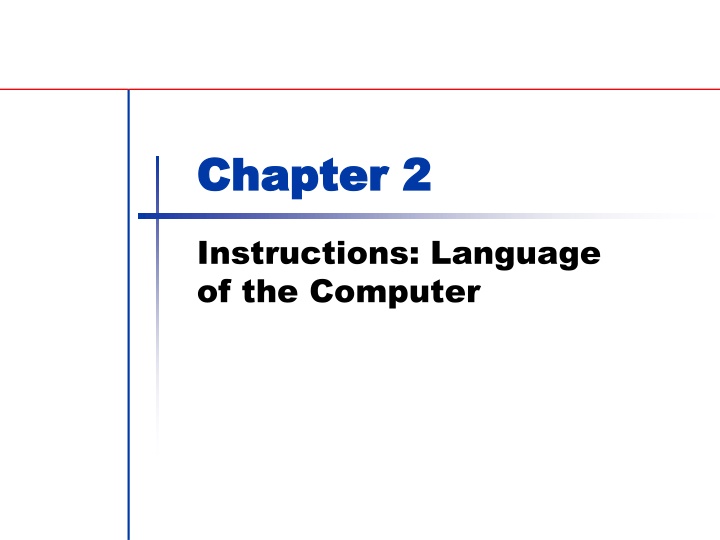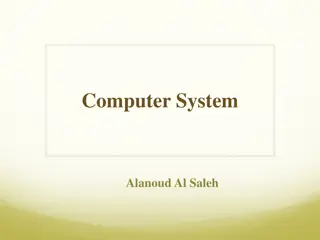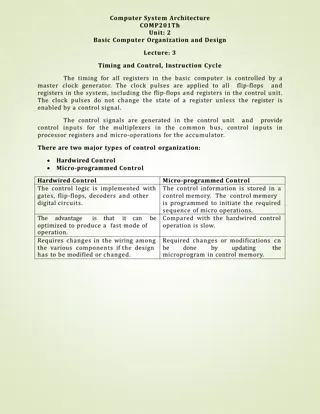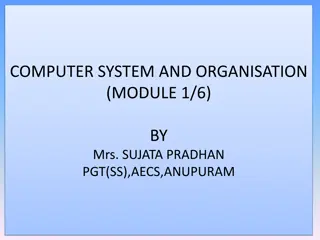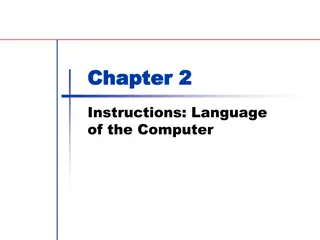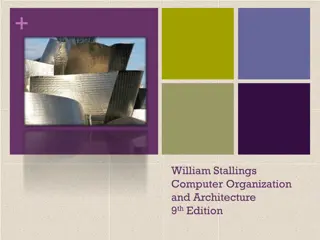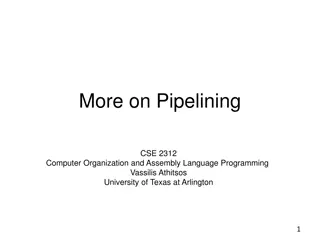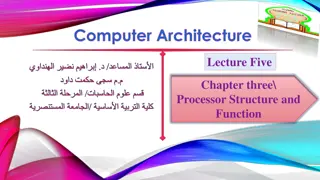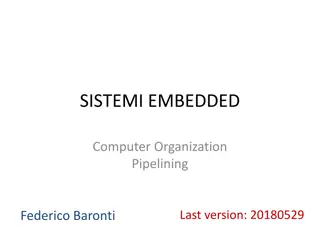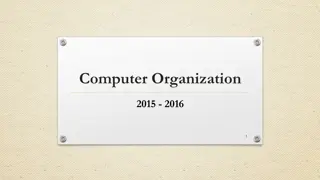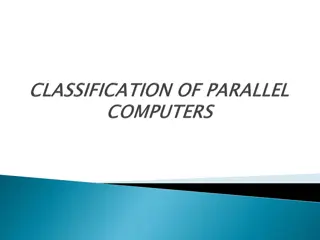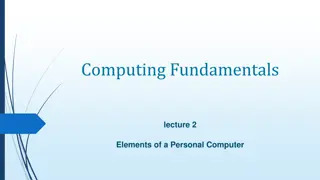Computer Organization and Design: Chapter 2 Instructions
Chapter 2 of "Computer Organization and Design: The Hardware/Software Interface" focusing on the language of the computer, operands of the computer hardware, and examples using registers and memory operands.
Uploaded on Mar 07, 2025 | 1 Views
Download Presentation

Please find below an Image/Link to download the presentation.
The content on the website is provided AS IS for your information and personal use only. It may not be sold, licensed, or shared on other websites without obtaining consent from the author.If you encounter any issues during the download, it is possible that the publisher has removed the file from their server.
You are allowed to download the files provided on this website for personal or commercial use, subject to the condition that they are used lawfully. All files are the property of their respective owners.
The content on the website is provided AS IS for your information and personal use only. It may not be sold, licensed, or shared on other websites without obtaining consent from the author.
E N D
Presentation Transcript
COMPUTER ORGANIZATIONAND DESIGN The Hardware/Software Interface Chapter 2 Chapter 2 Instructions: Language of the Computer
2.3 Operands of the Computer Hardware Register Operands Arithmetic instructions use register operands LEGv8 has a 32 64-bit register file Use for frequently accessed data 64-bit data is called a doubleword 31 x 64-bit general purpose registers X0 to X30 32-bit data called a word 31 x 32-bit general purpose sub-registers W0 to W30 Why only 32 registers? Design Principle 2: Smaller is faster the number of bits it would take in the instruction format c.f. main memory: millions of locations
LEGv8 Registers X0 X7: procedure arguments/results X8: indirect result location register X9 X15: temporaries X16 X17 (IP0 IP1): may be used by linker as a scratch register, other times as temporary register X18: platform register for platform independent code; otherwise a temporary register X19 X27: saved X28 (SP): stack pointer X29 (FP): frame pointer X30 (LR): link register (return address) XZR (register 31): the constant value 0
Register Operand Example Compiling a C Assignment Using Registers: f = (g + h) - (i + j); f, g, h, i, j in X19, X20, X21, X22, X23 Compiled LEGv8 code: ADD X9, X20, X21 // register X9 contains g + h ADD X10, X22, X23 // register X10 contains i + j SUB X19, X9, X10 // f gets X9 X10, which is (g + h) (i + j)
Memory Operands Main memory used for composite data Arrays, structures, dynamic data Data transfer instructions: transfer data between memory and registers (load and store) To access a word or doubleword in memory, the instruction must supply the memory address, usually starting at 0.
Memory Operands To apply arithmetic operations Load values from memory into registers Store result from register to memory Memory is byte addressed Each address identifies an 8-bit byte LEGv8 does not require words to be aligned in memory, except for instructions and the stack LDUR load register, U for unscaled immediate STUR store register
Memory Operand Example Compiling Using Load and Store: A[12] = h + A[8]; h in X21, base address of A in X22 Compiled LEGv8 code: Index 8 requires offset of 64 (8x8) Index 12 requires offset of 96 (8x12) LDUR X9,[X22,#64] // Temporary reg X9 gets A[8] ADD X9,X21,X9 // Temporary reg X9 gets h + A[8] STUR X9,[X22,#96] //Stores h + A[8] back into A[12]
Registers vs. Memory Registers are faster to access and have higher throughput than memory also uses much less energy than accessing memory Operating on memory data requires loads and stores More instructions to be executed Compiler must use registers for variables as much as possible Only spill to memory for less frequently used variables, called spilling registers Register optimization is important! Assuming 64-bit data, registers are roughly 200 times faster (0.25 vs. 50 nanoseconds) and are 10,000 times more energy efficient (0.1 vs. 1000 picoJoules) than DRAM in 2015.
Constant or Immediate Operands Constant data specified in an instruction ADDI X22, X22, #4 // X22 = X22 + 4 ADDI - add immediate Design Principle 3: Make the common case fast Small constants are common Immediate operand avoids a load instruction LEGv8 dedicates a register XZR to be hard- wired to the value zero (register number 31)
2.4 Signed and Unsigned Numbers Unsigned Binary Integers Given an n-bit number = + + + + n 1 n 2 1 0 x x 2 x 2 x 2 x 2 n 1 n 2 1 0 Range: 0 to +2n 1 Example 0000 0000 0000 0000 0000 0000 0000 10112 = 0 + + 1 23 + 0 22 +1 21 +1 20 = 0 + + 8 + 0 + 2 + 1 = 1110 Using 32 bits 0 to +4,294,967,295
2s-Complement Signed Integers Given an n-bit number = + + + + n 1 n 2 1 0 x x 2 x 2 x 2 x 2 n 1 n 2 1 0 Range: 2n 1 to +2n 1 1 Example 1111 1111 1111 1111 1111 1111 1111 11002 = 1 231 + 1 230+ + 1 22 +0 21 +0 20 = 2,147,483,648 + 2,147,483,644 = 410 Using 32 bits 2,147,483,648 to +2,147,483,647
2s-Complement Signed Integers Bit 31 is sign bit 1 for negative numbers 0 for non-negative numbers ( 2n 1) can t be represented Non-negative numbers have the same unsigned and 2s-complement representation Some specific numbers 0: 0000 0000 0000 1: 1111 1111 1111 Most-negative: 1000 0000 0000 Most-positive: 0111 1111 1111
Signed Negation Complement and add 1 Complement means 1 0, 0 1 + = = x x 1111...111 1 2 + = x 1 x Example: negate +2 +2 = 0000 0000 0010two 2 = 1111 1111 1101two + 1 = 1111 1111 1110two
Sign Extension Representing a number using more bits Preserve the numeric value Replicate the sign bit to the left c.f. unsigned values: extend with 0s Examples: 8-bit to 16-bit +2: 0000 0010 => 0000 0000 0000 0010 2: 1111 1110 => 1111 1111 1111 1110 In LEGv8 instruction set LDURSB: sign-extend loaded byte LDURB: zero-extend loaded byte
2.5 Representing Instructions in the Computer Representing Instructions Instructions are encoded in binary Called machine code LEGv8 instructions Encoded as 32-bit instruction words Small number of formats encoding operation code (opcode), register numbers, Simplicity favors regularity! 15
Hexadecimal Base 16 Compact representation of bit strings 4 bits per hex digit 0 1 2 3 0000 0001 0010 0011 4 5 6 7 0100 0101 0110 0111 8 9 a b 1000 1001 1010 1011 c d e f 1100 1101 1110 1111 Example: eca8 6420 1110 1100 1010 1000 0110 0100 0010 0000 16
LEGv8 R-format Instructions opcode Rm shamt Rn Rd 11 bits 5 bits 6 bits 5 bits 5 bits Instruction fields opcode: operation code Rm: the second register source operand shamt: shift amount (00000 for now) Rn: the first register source operand Rd: the register destination 17
R-format Example opcode Rm shamt Rn Rd 11 bits 5 bits 6 bits 5 bits 5 bits ADD X9,X20,X21 1112ten 21ten 0ten 20ten 9ten 10001011000two 10101two 000000two 10100two 01001two 1000 1011 0001 0101 0000 0010 1000 1001two = 8B15028916 18
LEGv8 D-format Instructions opcode address op2 Rn Rt 11 bits 9 bits 2 bits 5 bits 5 bits Load/store instructions Rn: base register address: constant offset from contents of base register (+/- 32 doublewords) Rt: destination (load) or source (store) register number Design Principle 3: Good design demands good compromises Different formats complicate decoding, but allow 32-bit instructions uniformly Keep formats as similar as possible 19
LEGv8 I-format Instructions immediate opcode Rn Rd 10 bits 12 bits 5 bits 5 bits Immediate instructions, e.g. ADDI, SUBI Rn: source register Rd: destination register Immediate field is zero-extended Reduce the complexity by keeping the formats similar Figure 2.5 LEGv8 instruction encoding. In the table above, reg means a register number between 0 and 31, address means a 9-bit address or 12-bit constant, and n.a. (not applicable) means this field does not appear in this format. The op2 field expands the opcode field. 20
Example Translating LEGv8 Assembly Language into Machine Language A[30] = h + A[30] + 1; X10 has the base of the array A and X21 corresponds to h Compiled LEGv8 code: LDUR X9, [X10,#240] // Temporary reg X9 gets A[30] ADD X9,X21,X9 // Temporary reg X9 gets h+A[30] ADDI X9,X9,#1 // Temporary reg X9 gets h+A[30]+1 STUR X9, [X10,#240] // Stores h+A[30]+1 back into A[30] Machine language instructions using decimal numbers: opcode Rm/ address /op2 shamt Rn Rd/Rt 1986 240 0 10 9 11111000010 011110000 00 01010 01001 1112 9 0 21 9 10001011000 01001 000000 10101 01001 580 1 9 9 1001000100 000000000001 01001 01001 21 1984 240 0 10 9 11111000000 011110000 00 01010 01001
Summary of LEGv8 machine language (till this point) Figure 2.6 LEGv8 architecture revealed through Section 2.5. The three LEGv8 instruction formats so far are R, I and D. The last 10 bits contain a Rn field, giving one of the sources; and the Rd or Rt field, which specifies the destination register, except for store register, where it specifies the value to be stored. R-format divides the rest into an 11-bit opcode; a 5-bit Rm field, specifying the other source operand; and a 6-bit shamt field, which Section 2.6 explains. I-format combines 12 bits into a single immediate field, which requires shrinking the opcode field to 10 bits. The D-format uses a full 11-bit opcode like the R-format, plus a 9-bit address field, and a 2-bit op2 field. The op2 field is logically an extension of the opcode field. 22
Stored Program Computers Instructions represented in binary, just like data Instructions and data stored in memory Programs can operate on programs e.g., compilers, linkers, Binary compatibility allows compiled programs to work on different computers Standardized ISAs The BIG Picture The BIG Picture 23
2.6 Logical Operations Logical Operations Instructions for bitwise manipulation Operation Shift left Shift right Bit-by-bit AND Bit-by-bit OR Bit-by-bit NOT C << >> & | ~ Java << >>> & | ~ LEGv8 LSL LSR AND, ANDI OR, ORI EOR, EORI Useful for extracting and inserting groups of bits in a word 24
